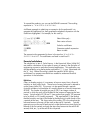
Page 6-9
To expand the products, you can use the EXPAND command. The resulting
expression is: '
X^4+-3*X^3+ -3*X^2+11*X-6'.
A different approach to obtaining an expression for the polynomial is to
generate the coefficients first, then generate the algebraic expression with the
coefficients highlighted. For example, for this case try:
‚Ϙ˜@@OK@@ Select Solve poly…
˜„Ô1‚í3 Enter vector of roots
‚í2\‚í 1@@OK@@
@SOLVE@ Solve for coefficients
˜@SYMB@ Generate symbolic expression
` Return to stack.
The expression thus generated is shown in the stack as: '
X^4+-3*X^3+ -
3*X^2+11*X+-6*X^0'
. The coefficients are listed in stack level 2.
Financial calculations
The calculations in item 5. Solve finance.. in the Numerical Solver (NUM.SLV)
are used for calculations of time value of money of interest in the discipline of
engineering economics and other financial applications. This application can
also be started by using the keystroke combination „sÒ (associated with
the 9 key). Before discussing in detail the operation of this solving
environment, we present some definitions needed to understand financial
operations in the calculator.
Definitions
Often, to develop projects, it is necessary to borrow money from a financial
institution or from public funds. The amount of money borrowed is referred to
as the Present Value (PV). This money is to be repaid through n periods
(typically multiples or sub-multiples of a month) subject to an annual interest rate
of I%YR. The number of periods per year (P/YR) is an integer number of
periods in which the year will be divided for the purpose of repaying the loan
money. Typical values of P/YR are 12 (one payment per month), 24 (payment
twice a month), or 52 (weekly payments). The payment(PMT) is the amount
that the borrower must pay to the lender at the beginning or end of each of the
n periods of the loan. The future value of the money (FV) is the value that the
borrowed amount of money will be worth at the end of n periods. Typically
payment occurs at the end of each period, so that the borrower starts paying at
the end of the first period, and pays the same fixed amount at the end of the
second, third, etc., up to the end of the n-th period.


















